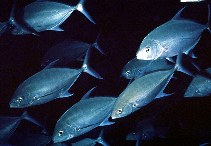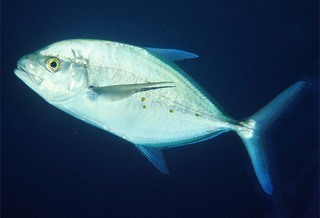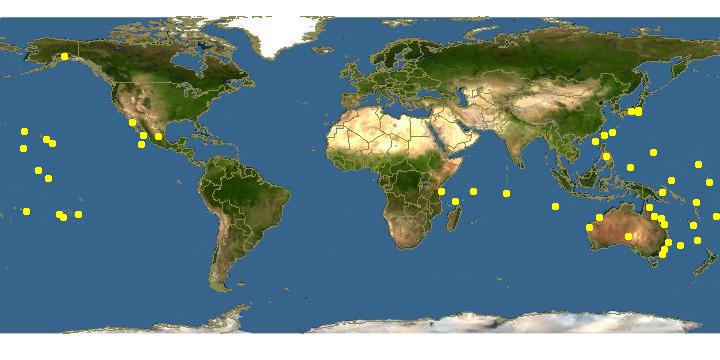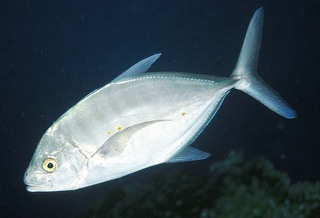|
| Links |
We parsed the following live from the Web into this page. Such content is managed by its original site and not cached on Discover Life. Please send feedback and corrections directly to the source. See original regarding copyrights and terms of use.
- Australian Faunal Directory
- FishBase
|
|
espa˝ol |
|
|
Overview |
Main identification features
- oval shape
- flank: ~6 oval yellow spots
Body deep, compressed; head profile convex; dorsal rays VIII + I, 29-32; anal rays II + I, 24-36; gill rakers on first arch (excluding rudiments) 8-10 + 20-23; lateral line anteriorly with very slight arch, the curved part slightly longer than or equal to straight part; scales on straight part of lateral line 21-34, followed by 19-31 small scutes; distinguishing features include short dorsal and anal fin lobes, and isolated scaleless areas on breast and base of pectoral fins.
Generally silvery, brassy to greenish blue on back and whitish on ventral parts; adults with several, relatively large elliptical yellow spots on side.
Size: attains 71 cm.
Habitat: around reefs
Depth: 3-170 m.
Widely distributed in the Indo-Pacific region from East Africa to the Americas; in the eastern Pacific known from the tip of Baja, Clipperton, the Revillagigedos, Cocos, Malpelo, Galapagos and Tres Marias islands (central Mexico).
Attributes
Abundance: Common.
Cites: Not listed.
Climate Zone: Northern Tropical (Mexican Province to Nicaragua + Revillagigedos); Equatorial (Costa Rica to Ecuador + Galapagos, Clipperton, Cocos, Malpelo); Northern Subtropical (Cortez Province + Sinaloan Gap).
Depth Range Max: 170 m.
Depth Range Min: 3 m.
Diet: mobile benthic crustacea (shrimps/crabs).
Eastern Pacific Range: Northern limit=25; Southern limit=-2; Western limit=-115; Eastern limit=-82; Latitudinal range=27; Longitudinal range=33.
Egg Type: Pelagic; Pelagic larva.
Feeding Group: Carnivore.
FishBase Habitat: Pelagic.
Global Endemism: All Pacific (West + Central + East); Indo-Pacific only (Indian + Pacific Oceans); TEP non-endemic; "Transpacific" (East + Central &/or West Pacific); All species.
Habitat: Corals; Reef associated (reef + edges-water column & soft bottom); Rocks; Reef (rock &/or coral); Estuary; Water column.
Inshore Offshore: Inshore; Inshore Only.
IUCN Red List: Not evaluated / Listed.
Length Max: 71 cm.
Regional Endemism: Island (s); Continent; Continent + Island (s); Eastern Pacific non-endemic; Tropical Eastern Pacific (TEP) non-endemic; All species.
Residency: Resident.
Salinity: Marine; Brackish.
Water Column Position: Bottom; Mid Water; Near Bottom; Bottom + water column;
|
|
|
Names | |
|
|
|
Links to other sites | |
|
|
|
References |
- Allen , G.R. and Robertson, D.R., 1997., An Annotated Checklist of the fishes of Clipperton Atoll, Tropical Eastern Pacific., Revista de Biologia Tropical, 45:813-843.
- Castro-Aguirre, J.L. and Balart, E.F., 2002., La ictiofauna de las islas Revillagigedos y sus relaciones zoogeograficas, con comentarios acerca de su origen y evolucion. En: Lozano-Vilano, M. L. (Ed.). Libro Jubilar en Honor al Dr. Salvador Contreras Balderas., Universidad Autonoma de Nuevo Leˇn:153-170.
- Findley, L.T., Hendrickx, M.E., Brusca, R.C., van der Heiden, A.M., Hastings, P.A., Torre, J., 2003., Diversidad de la Macrofauna Marina del Golfo de California, Mexico., CD-ROM versiˇn 1.0. Projecto de la Macrofauna del Golfo .á Derechos reservados de los autores y Conservaciˇn Internacional.
- Fischer , W. , Krup , F. , Schneider , W. , Sommer , C. , Carpenter , K. E. and Niem, V. H., 1995., Guia FAO para la Identificacion de Especies de para los fines de la Pesca. Pacifico Centro-Oriental. Volumen II. Vertebrados - Parte 1., FAO2:647-1200.
- Jordan , D.S. and Gilbert, C.H., 1882., Notes on a collection of fishes made by Lieut. Henry E. Nichols, U.S.N., on the west coast of Mexico, with descriptions of new species., Proc. U.S. Nat. Mus., 4:225-233.
- Jordan , and McGregor,., 1898., List of fishes collected at the Revillagigedo archipelago and neighboring islands., Rept. U.S. Fisheries Comm., 24:271-284.
- Love, M.S., Mecklenburg, C.W., Mecklenburg, T.A., Thorsteinson, L.K., 2005., es of the West Coast and Alaska: a checklist of North Pacific and Artic Ocena species from Baja California to the Alaska-Yukon border., U.S. Department of the Interior, U.S. Geological Survey, Biological Resources Division, 288pp.
- Ricker, K.E., 1959., Fishes collected from the Revillagigedo Islands during the 1954-1958 cruises of the "Marijean."., Univ. Brit. Columbia Inst. Fish., Mus. Contrib., 4:10pp.
- Robertson , D.R. and Allen, G.A., 1996., Zoogeography of the shorefish fauna of Clipperton Atoll., Coral Reefs, 15:121-131.
- Snodgrass , R. E. and Heller, E., 1905., Papers from the Hopkins Stanford Galapagos expedition, 1898-1899. XVII. Shorefishes of the Revillagigedo, Clipperton, Cocos and Galapagos Island., Proc. Wash. Acad. Sci., 6:333-427.
- Walker, B. W. and Baldwin, W. J., 1964., Provisional check list of fishes of the Revillagigedo islands., 18 pp.
|
|
|
Acknowledgements | |
I thank Ashley MacDonald and John Pickering, University of Georgia, for technical support in building this page.
|
|
| Supported by | |
|
Following modified from Australian Faunal Directory
|
Top | See original
| &pull 20q v5.145 20180528: Error 301 Moved Permanently http://biodiversity.org.au/afd/taxa/260652fd-15c9-446c-8edc-2e265cf38005 |
|
Following modified from FishBase
|
Top | See original
http://www.fishbase.org/Summary/speciesSummary.php?genusname=Carangoides&speciesname=orthogrammus ---> http://fishbase.de/Summary/speciesSummary.php?genusname=Carangoides&speciesname=orthogrammus
http://fishbase.de/Summary/speciesSummary.php?genusname=Carangoides&speciesname=orthogrammus ---> https://fishbase.de/Summary/speciesSummary.php?genusname=Carangoides&speciesname=orthogrammus
https://fishbase.de/Summary/speciesSummary.php?genusname=Carangoides&speciesname=orthogrammus ---> http://fishbase.de/summary/Carangoides-orthogrammus.html
http://fishbase.de/summary/Carangoides-orthogrammus.html ---> https://fishbase.de/summary/Carangoides-orthogrammus.html
Ferdauia orthogrammus, Island trevally : fisheries, gamefish

You can
sponsor
this page
Common name (e.g. trout)
Genus + Species (e.g. Gadus morhua)
-

-
About this page
-
Languages
-
User feedbacks
-
Citation
-
Uploads
-
Related species
-


 Island trevally
Upload your
photos
and
videos
Island trevally
Upload your
photos
and
videos
Pictures
|
Videos |
Google image
 Ferdauia orthogrammus
Ferdauia orthogrammus
Picture by
Randall, J.E.
Classification / Names
Common names
|
Synonyms
| Catalog of Fishes(
genus
,
species
) |
ITIS
|
CoL
|
WoRMS
|
Cloffa
Teleostei (teleosts) >
Carangiformes
(Jacks) >
Carangidae
(Jacks and pompanos) > Caranginae
Etymology: More on authors:
Jordan
&
Gilbert
.
Environment: milieu / climate zone / depth range / distribution range
Ecology
Marine; reef-associated; oceanodromous (Ref.
51243
); depth range 0 - 168 m (Ref.
9710
). Tropical; 35°N - 34°S, 35°E - 113°W
Indo-Pacific: western Indian Ocean to the Austral Islands, north to southern Japan and Hawaii, south to Sydney, Australia. Eastern Central Pacific: Mexico and the Revillagigedo Islands (Ref.
9283
).
Size / Weight / Age
Maturity: L
m
?
range ? - ? cm
Max length : 75.0 cm TL male/unsexed; (Ref.
48635
); common length : 40.0 cm FL male/unsexed; (Ref.
3287
); max. published weight: 6.6 kg (Ref.
40637
)
Dorsal
spines
(total): 9;
Dorsal
soft rays
(total): 28-31;
Anal
spines
: 3;
Anal
soft rays
: 24 - 26.
Adults are pelagic and are abundant around oceanic islands while not found in neritic areas (Ref.
9283
,
58302
). May be encountered in solitary, pairs or small schools. Schools frequent sandy river basins, sandy channels of lagoon and seaward reefs. Feed on small crustaceans in the sand (Ref.
9283
). Marketed fresh and dried or salted (Ref.
9283
). Minimum depth reported taken from Ref. 128797.
Life cycle and mating behavior
Maturity
|
Reproduction
|
Spawning
|
Eggs
|
Fecundity
|
Larvae
Paxton, J.R., D.F. Hoese, G.R. Allen and J.E. Hanley
, 1989. Pisces. Petromyzontidae to Carangidae. Zoological Catalogue of Australia, Vol. 7. Australian Government Publishing Service, Canberra, 665 p. (Ref.
7300
)
IUCN Red List Status (Ref.
130435
)
Least Concern (LC)
; Date assessed:
09 March 2015
CITES
Not Evaluated
Not Evaluated
Threat to humans
Harmless
Human uses
Fisheries: commercial; gamefish: yes
FAO - Publication:
search
|
FishSource
|
Sea Around Us
More information
Countries
FAO areas
Ecosystems
Occurrences
Introductions
Stocks
Ecology
Diet
Food items
Food consumption
Ration
Common names
Synonyms
Metabolism
Predators
Ecotoxicology
Reproduction
Maturity
Spawning
Spawning aggregation
Fecundity
Eggs
Egg development
Age/Size
Growth
Length-weight
Length-length
Length-frequencies
Morphometrics
Morphology
Larvae
Larval dynamics
Recruitment
Abundance
BRUVS
References
Aquaculture
Aquaculture profile
Strains
Genetics
Electrophoreses
Heritability
Diseases
Processing
Nutrients
Mass conversion
Collaborators
Pictures
Stamps, Coins Misc.
Sounds
Ciguatera
Speed
Swim. type
Gill area
Otoliths
Brains
Vision
Tools
Bio-Quiz
|
E-book
|
Field guide
|
Identification keys
|
Length-frequency wizard
|
Life-history tool
|
Point map
|
Classification Tree
|
Catch-MSY
|
Special reports
Check for Aquarium maintenance
|
Check for Species Fact Sheets
|
Check for Aquaculture Fact Sheets
Download XML
Summary page
|
Point data
|
Common names
|
Photos
Internet sources
AFORO (otoliths) |
Aquatic Commons
|
BHL
|
Cloffa
|
BOLDSystems
|
Websites from users
|
Check FishWatcher
|
CISTI
|
Catalog of Fishes
:
genus
,
species
|
DiscoverLife
|
ECOTOX
| FAO - Publication:
search
|
Faunafri
| Fishipedia |
Fishtrace
| GenBank:
genome
,
nucleotide
|
GloBI
|
Google Books
|
Google Scholar
|
Google
|
IGFA World Record
|
MitoFish
|
National databases
|
Otolith Atlas of Taiwan Fishes
|
PubMed
|
Reef Life Survey
| Socotra Atlas |
Tree of Life
| Wikipedia:
Go
,
Search
| World Records Freshwater Fishing |
Zoological Record
Estimates based on models
Preferred temperature (Ref.
123201
): 23.7 - 29, mean 27.7 °C (based on 1736 cells).
Phylogenetic diversity index (Ref.
82804
): PD
50
= 0.5000 [Uniqueness, from 0.5 = low to 2.0 = high].
Bayesian length-weight: a=0.01349 (0.00855 - 0.02128), b=2.97 (2.84 - 3.10), in cm total length, based on LWR estimates for this species & Genus-body shape (Ref.
93245
).
Trophic level (Ref.
69278
): 4.5 ±0.0 se; based on diet studies.
Resilience (Ref.
120179
): Medium, minimum population doubling time 1.4 - 4.4 years (Preliminary K or Fecundity.).
Fishing Vulnerability (Ref.
59153
): Moderate to high vulnerability (50 of 100).
Price category (Ref.
80766
):
Medium
.
Nutrients (Ref.
124155
): Calcium = 23.6 [14.3, 51.5] mg/100g; Iron = 1.17 [0.55, 2.38] mg/100g; Protein = 20.2 [17.6, 22.3] %; Omega3 = 0.181 [0.104, 0.324] g/100g; Selenium = 12.1 [6.1, 25.5] ╬╝g/100g; VitaminA = 78.6 [14.3, 432.6] ╬╝g/100g; Zinc = 0.533 [0.283, 1.149] mg/100g (wet weight); based on
nutrient studies.
Back to Search
Random Species
Back to Top
Accessed through:
Not available
FishBase mirror site :
localhost
Page last modified by :
mrius-barile
- 20 July 2016
Fatal error
: Uncaught ArgumentCountError: Too few arguments to function checkEcotox(), 1 passed in /var/www/html/summary/SpeciesSummary.php on line 2304 and exactly 3 expected in /var/www/html/includes/speciessummary.lib.php:2580 Stack trace: #0 /var/www/html/summary/SpeciesSummary.php(2304): checkEcotox() #1 {main} thrown in
/var/www/html/includes/speciessummary.lib.php
on line
2580
|
Updated: 2024-04-23 23:16:38 gmt
|







